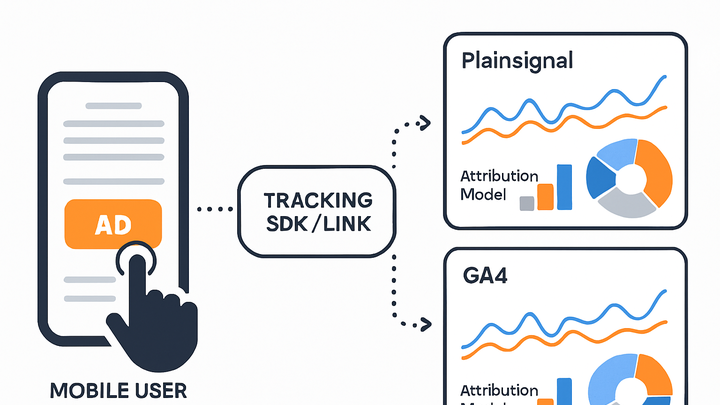Published on 2025-06-22T08:24:21Z
What is Mobile Attribution? Examples with PlainSignal and GA4.
Mobile Attribution is the process of assigning credit for app installs and in-app events to the marketing touchpoints (ads, emails, social posts) that led to those actions. It enables marketers to measure which campaigns, channels, and creatives are most effective at driving user acquisition and engagement. By analyzing attribution data, teams can optimize budgets, improve targeting, and accurately calculate ROI. Mobile attribution typically involves integrating an analytics SDK or tracking snippet into the app or landing pages, collecting click- and view-through data, and applying an attribution model (e.g., last-click, multi-touch) to determine credit. Leading solutions like PlainSignal and Google Analytics 4 (GA4) offer cookie-free and cross-platform attribution respectively, adapting to privacy regulations and evolving user behavior. Accurate mobile attribution is crucial for data-driven decision-making in competitive app marketing.
Mobile attribution
Mobile attribution credits app installs and in-app actions to marketing touchpoints, enabling ROI analysis and campaign optimization.
Overview of Mobile Attribution
Mobile attribution tracks how users discover and engage with mobile apps across different marketing channels. It provides visibility into which ads or organic sources drive installs and key in-app events.
-
Definition
The process of mapping user installs and events back to the marketing interactions that preceded them.
-
Key goals
Identify top-performing campaigns, allocate budgets effectively, and measure campaign ROI.
Key Components of Mobile Attribution
A robust mobile attribution setup relies on several core components to collect, process, and report data accurately.
-
Tracking urls and sdks
Unique tracking links or embedded SDKs capture click and install data from ad networks and channels.
-
Attribution models
Rules that determine how credit is assigned to touchpoints in the user journey.
-
Last-click
Gives all credit to the final click or view before the install.
-
First-click
Gives all credit to the first interaction a user had.
-
Multi-touch
Distributes credit across multiple interactions based on predefined weights.
-
-
Event mapping
Align in-app events (e.g., sign-ups, purchases) with marketing triggers for granular performance analysis.
Implementation with PlainSignal and GA4
Here’s how to set up mobile attribution using PlainSignal’s cookie-free analytics snippet and Google Analytics 4.
-
PlainSignal setup
Insert the following code snippet into your app’s webview or landing page to enable cookie-free tracking:
<link rel="preconnect" href="//eu.plainsignal.com/" crossorigin /> <script defer data-do="yourwebsitedomain.com" data-id="0GQV1xmtzQQ" data-api="//eu.plainsignal.com" src="//cdn.plainsignal.com/plainsignal-min.js"></script>This snippet initializes PlainSignal’s tracker, captures click and referer data, and sends it to the PlainSignal API.
-
GA4 setup
Add the GA4
gtag.jsscript to your app’s web context or integrate the GA4 SDK for native apps:<script async src="https://www.googletagmanager.com/gtag/js?id=G-XXXXXXXXXX"></script> <script> window.dataLayer = window.dataLayer || []; function gtag(){dataLayer.push(arguments);} gtag('js', new Date()); gtag('config', 'G-XXXXXXXXXX'); </script>Configure events like
first_open,purchase, or custom events to track user actions in your GA4 property.
Best Practices and Considerations
To maximize accuracy and compliance, follow these best practices when implementing mobile attribution.
-
Respect user privacy
Adhere to GDPR, CCPA, and other regulations by minimizing personal data collection and honoring opt-out signals.
-
Configure attribution windows
Choose appropriate lookback windows (e.g., 7, 30 days) to match campaign length and user behavior patterns.
-
Prevent attribution fraud
Use fraud detection tools and validate installs with a trusted Mobile Measurement Partner (MMP).
